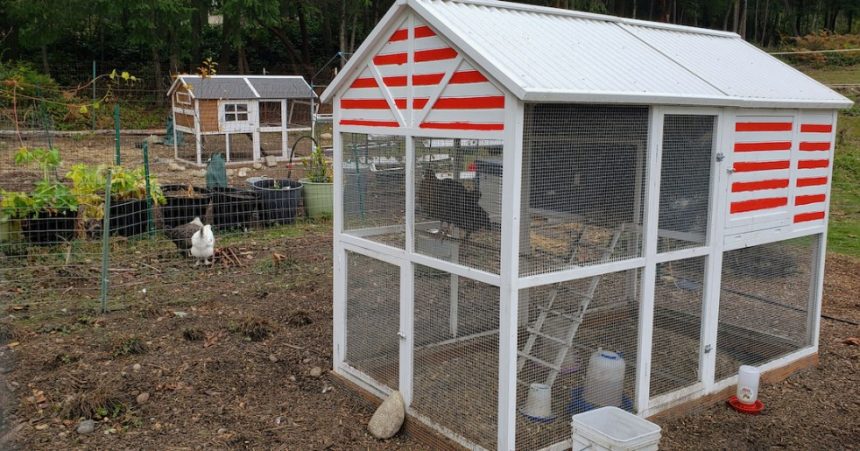Are you ready to join the growing movement of homesteaders and start your own backyard farm? Raising chickens is a great place to start, and it’s easier than you think! Not only will you enjoy fresh, delicious eggs and meat, but you’ll also experience the satisfaction of being more self-sufficient and connected to the natural world. In this article, I’ll show you how to get started with your own backyard chicken farm, from choosing the right breeds to building a safe and healthy coop. Whether you’re a seasoned farmer or a beginner, I’ll guide you through the process of raising happy, healthy chickens and enjoying the many benefits of backyard farming.
Getting Started: Chicken Breeds
When getting started with homestead chickens, one of the most important decisions is which chicken breeds to choose. There are hundreds of chicken breeds, but they can generally be grouped into these main categories:
- Egg laying breeds: Focus on high egg production rather than meat. Examples include Leghorns, Rhode Island Reds, Ameraucanas. White or brown eggs.
- Dual purpose breeds: Provide both a decent number of eggs and meat. Examples include Orpingtons, Plymouth Rocks, Wyandottes. Brown eggs.
- Meat breeds: Focus on fast growth and meat production over eggs. Examples include Cornish, Brahma, Jersey Giant. Brown eggs.
- Heritage breeds: Traditional breeds with unique colors and patterns bred over decades or centuries. Usually dual purpose. Examples include Marans, Buckeyes, Houdans. White or brown eggs.
The breed you select will depend on your main purpose (eggs vs. meat), desired appearance, climate conditions and whether you want fast growing industrial breeds or slower growing heritage breeds. Each breed has slightly different husbandry needs, so do your research. You may also want to select more than one breed to have both egg layers and meat birds.
Housing Set Up and Equipment
Proper housing and equipment is key to keeping backyard chickens healthy, safe and productive. Here are the essential elements:
- Coop: The chicken coop provides overnight and bad weather housing for the flock. It should offer about 4 square feet per bird of well-ventilated space, with nesting boxes for egg-laying hens and perches for birds to roost. Clean with new bedding regularly.
- Run/Pen: Attached to the coop, the outdoor run or pen allows chickens to get fresh air and sunshine while protected from predators when you’re not home. Size depends on flock size but figure 8-10 square feet per bird.
- Feeders and Waterers: Use sturdy feeders and waterers that protect feed from getting soiled and are designed for bird use, hanging at chest height for standard-sized chickens. Have at least 1.5 foot of feeder space and 1 gallon of water per three birds.
- Heat Lamp/Brooder (for chicks): Baby chicks need to be kept at 95°F for their first week and 90° later, tapering down. Use a heat lamp or brooder with a thermometer to maintain temperature.
- Bedding: Inside the coop and nesting boxes use 4-6 inches of absorbent bedding material like wood chips, straw or pine shavings to soak up manure.
- Grit: Provide a supplement of insoluble granite grit to help chickens digest feed in their gizzards, support egg shell production and provide calcium.
- Supplements: Consider providing oyster shell for extra calcium and a poultry vitamin supplement according to package directions to support egg production and health.
- Fencing: Use welded wire or chicken wire to keep birds enclosed and deter digging predators. Bury the bottom edge or use an apron to prevent animals digging underneath.
- Protection: Hardware cloth and latches on doors will prevent predators like foxes, coyotes, raccoons or opossums from entering the coop. Automatic doors are a useful upgrade.
Getting and Caring for Chicks
Chicken keeping starts with acquiring baby chicks and raising them to adulthood. Here is what you need to know:
- Purchasing: Buy from a local farm store or reputable national hatchery that sells sexed chicks (females for layers, males/both for meat). Minimum order is usually 25 chicks. Select healthy, active chicks showing no signs of illness.
- Brooding: Keep chicks warm with a heat lamp or brooder, starting at 95°F and reducing 5 degrees per week. Use chick feed and grit specifically for young birds along with clean water. Avoid drafts.
- Transitioning: At about 5-8 weeks old, chicks will grow feathers replacing down and can handle fluctuations in temperature. They can transition to life outdoors full-time at this stage.
- Coop & Run: Give chicks access to the coop and run during the day only at first, starting at 2-3 weeks old once they are fully feathered out. This helps avoid piling/smothering with unregulated heat lamp. Expand daytime access as they grow. At 12-15 weeks, they can sleep in the coop full time.
- Health Issues: Watch for pasty butt (clean gently with wet cloth), splayed legs (wrap legs gently with bandage), picky eating, respiratory issues, parasites and injuries. Isolate and treat any sick birds promptly. Support good health with proper feed, space requirements and biosecurity measures. Cull birds that don’t respond to treatment.
Feed and Nutrition
Proper nutrition is essential for backyard chickens. Follow these feeding guidelines:
| Chick starter | Keep chicks on a 20-24% protein chick starter feed with built-in medication for immunity for the first 12-15 weeks. |
| Layer feed | Switch hens to a 16-18% protein complete layer feed/pellet between 15-18 weeks old before they start laying eggs. Formulated to support egg production. |
| Scratch grains | In addition to complete feeds, offer a commercial small grain scratch mix for variety. 1-2 handsful per bird per day. |
| Grit/Oyster Shell | Free choice insoluble granite grit should always be available from day 1 to help digest food. Supplement older hens with oyster shell. |
| Treats | Kitchen scraps, garden/lawn waste, mealworms and scratch make great supplemental treats in small amounts as long as main nutrition comes from commercial feed. Avoid old produce. |
| Feeders | Use sturdy hanging feeders to prevent waste. Provide at least 1.5 linear foot per bird. Refill daily with fresh feed; discard wet or soiled feed. |
| Water | Always keep clean drinking water available in automatic or refillable waterers. Clean waterers weekly. Provide heaters for winter if temperatures fall below freezing. |
| Pasture access | When possible, allow chickens to free range on rotated pastures to forage for weeds, seeds, grubs and plants, taking pressure off supplemental feeds. |
| Adjust as needed | Monitor body condition score and egg production rate. Increase feed ration or protein content if birds get too thin or egg production drops. |
Egg Laying Management
Collecting and storing fresh eggs is a daily task. Follow these tips:
- Onset: Pullets (young hens under 1 year) will generally start laying between 16-24 weeks of age depending on breed, season and nutrition. Egg production rises steadily to a peak around 8 months old.
- Collecting: Collect eggs 2+ times per day; more often in hot weather. Gently clean nest boxes weekly. Discard any broken, odd shaped or dirty eggs.
- Cleaning: Use fine sandpaper, a dedicated egg cleaning pad or stiff brush to carefully buff stains or dirt off eggs before storage without washing (which removes protective cuticle).
- Storing: Place clean eggs pointy-end down in cartons immediately after collecting, stored at 55°F in the refrigerator to maintain freshness. Turn eggs daily.
- Production Changes: As hens near their first molt around 18 months old, egg laying will naturally decline by 30% or more. Production will subsequently ebb and flow for their lifetime.
- Tracking: Use an egg collection log to track when hens slow down production due to molting, winter light changes, aging or heat stress so you can supplement lighting, nutrition or adjust stock as needed.
Vermin Control
A backyard flock naturally attracts pests like flies, rodents and parasites looking for an easy feed source. Control them through prevention and management:
- Clean Coop – Clean the chicken coop fully between flocks to remove organic matter where flies and parasites breed. Remove manure regularly.
- Fly Control – Use fly strips, bait traps, parasitoid wasps, fly spray or release fly predator insects to reduce pest fly populations attracted to manure.
- Rodent Control – Close off or hardware cloth any openings bigger than 1/4 inch and use metal feed storage containers to avoid attracting mice. Set snap traps or bait stations well out of bird’s reach.
- Diatomaceous Earth – Apply food grade diatomaceous earth liberally in nest boxes and dust bathing areas or feed free choice at 1% of feed volume to control external and internal parasites.
- Ivermectin – Administer oral or injectable ivermectin parasite treatment if mites or lice infestations persist, especially in vent area. Withdraw eggs from treated hens.
- Biosecurity – Maintain separation between backyard and commercial flocks. Isolate new additions for one month before introducing. Control access to feed, water and bedding sources.
Predator Protection
Predators like foxes, hawks, raccoons and weasels can threaten free ranging chickens. Protect them with these methods:
- Hardware Cloth – Put 1/4 inch wire mesh around the bottom of fences or coops to stop animals from digging under them.
- Electric Fence – Use an electric chicken fence or add electric wire to your fence to keep predators away.
- Guard Animals – Keep dogs, donkeys, or llamas with your chickens to scare off predators.
- Coop Doors – Use strong latches, locks, and automatic door closers on the coop to keep chickens safe at night. Check that all birds are inside before dark.
- Range Supervision – When chickens are out in the yard, stay with them as much as you can to chase away predators. If you can’t watch them, keep them in the coop or run.
- Hawk Kites/Eye Spot Balloons – Hang fake hawk kites or shiny balloons with eye spots to scare away hawks and other birds that might eat your chickens.
Culling and Processing
As egg production wanes, illness takes hold or roosters become aggressive, you may need to remove birds from the flock using these humane methods:
- Culling Hens – As commercial egg laying breeds decline after 18-24 months, select non-productive hens for culling so you can replenish the flock with younger pullets.
- Emergency Culling – Immediately euthanize and dispose of very sick, injured or suffering chickens using cervical dislocation. Do not eat them.
- Slaughter age – Meat birds are generally processed between 9-13 weeks old depending on breed and desired carcass size, before their structural health declines.
- Butchering Roosters – Limit roosters to one per every 8-10 hens or they will fight. Dispatch excess juvenile roosters at 10-15 weeks for meat.
- Processing Setup – Butcher chickens humanely either on-farm or at a USDA approved facility. Chill carcasses quickly then freeze or preserve the meat.
FAQs
Provide a complete commercial layer feed to laying hens. Supplement with grit, oyster shell and scratch grains. Allow pasture access for foraging when possible.
On average, chickens live 5-8 years. Egg production declines after 18-24 months for commercial laying breeds.
Start with 3-5 chickens or if raising chicks get 6-10 to allow for any losses. Grow your flock slowly as you gain experience.
Hens make minimal noise. Roosters crow loudly/often. With good sanitation hens don’t smell much either.
No, hens will lay eggs without a rooster being present. The eggs will be infertile though.
Newly hatched chicks need 95°F, reduced by 5 degrees per week until fully feathered around 5-8 weeks old.
In Summary
Raising backyard chickens requires an investment of time, effort and financial resources to establish housing and care for the flock properly. But most homesteaders find the return of farm-fresh eggs, humanely raised meat, natural pest control, pet animals and recycling food waste to be extremely worthwhile. Follow this guide for the fundamentals of getting started, chick rearing, coop setup, nutrition, egg laying management, biosecurity and processing chickens harvested for meat so your small-scale poultry operation can be efficient, productive and enjoyable for years to come. Let those birds earn their keep!




